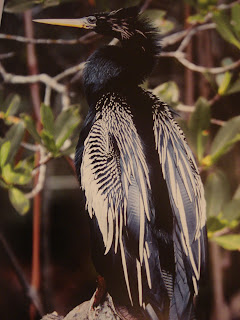 |
| little blue heron searching for a juicy snack. j.n. "ding" darling national wildlife refuge. january, 2011. |
the northern part of sanibel island is almost entirely a wildlife refuge. we saw hundreds of birds on the hot, sunny day we were there, including anhingas, great blue herons, little blue herons, egrets and roseate spoonbills. as usual, their focus was on eating. herons are unbelievable when it comes to grabbing a meal. they eat a wide variety of things, not just fish but also lizards, snakes, frogs, crabs, grasshoppers, dragonflies and aquatic insects. what opportunists! they'll eat anything they can swallow! the birds who were not actively pursuing a meal were actively pursuing a nap.
 |
| far, far in the distance, a flock of roseate spoonbills taking a nap. |
 |
| an anhinga drying his wings. |
 |
| a young blue heron. |
 |
| the only alligator i saw on sanibel island. |
darling, who was known as the best friend a duck ever had, was recruited by president franklin roosevelt in 1934 to be on the wildlife restoration committee, even though he was a staunch republican. the first duck stamp was designed by him in 1934. he organized various sportsmen groups into the national wildlife federation. mr.darling wrote two books, and won the pulitzer prize twice for cartooning.
a four mile, one way road winds through the middle of the ding darling sanctuary. you can stop and observe the wildlife whenever you want. there are also foot and bicycle paths. people were quiet and respectful of the wildlife the day we visited.
in the distance, hanging out on sandbars in the water and surrounded by protected mangrove forest, we also saw brown pelicans, white pelicans (what magnificent birds!), mergansers and egrets.

No comments:
Post a Comment